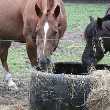
JOEHOE! Heb het artikel via Altavista gevonden zonder in te hoeven loggen en dus lid te worden van de AQHA!!!!
Zal de (voor mij) belangrijkste beweringen in het topic plakken, wil iemand al de antwoorden (PDF formaat) vraag het me dan mail ik het hele artikel:
Which of these commonly accepted truths on cryptorchid horses
are true and which are myths? By Larri Jo Starkey
HERE ARE THE FACTS ABOUT CRYPTORCHIDISM: IT’S A CONDITION in which one or both testicles are retained in the abdomen instead of descending into the scrotum. It’s seen in all domestic animals, and is common in stallions, boars and dogs.
You probably know that already. But it’s the other things you
“know” about cryptorchidism that might or might not be true.
The Journal asked equine reproduction specialist Benjamin
Espy, D.V.M., DACT, to clear up any misconceptions.
Test your knowledge against the facts.
Questions & answers:
2.) The retained testicle can develop cancer.
Cancerous growth in the retained testicle is rare, Espy said,
but not unknown.
“There’s such a small population of cryptorchid horses that
there really haven’t been any long-term studies about how to
assign risk to cancer in a retained testicle,” he said. “In other
species, it has been well-studied, and the increased temperature
is blamed for numerous tumor formations, so in general, cryptorchid horses are assumed to have a higher risk of cancer even though in general testicular cancer is really rare in horses.”
ANSWER = TRUE (Elza: het "KAN" maar kunnen ze bij paarden dus niet bewijzen! Ook is testikelkanker bij paarden in het algemeen zeldzaam, al heb je het dan wel over ingedaalde...)
3.) The retained testicle can produce sperm.
“The reason the scrotum is on any male, whether it’s a horse or
a human or a bull, is to regulate the temperature inside the testicle,”
Espy said. “If the testicle is retained in the abdomen, then that
male of whatever species is going to be sterile (in that testicle).”
The temperature inside the abdomen is too high for the
retained testicle to produce sperm.
ANSWER = FALSE
5.) The undescended testicle is painful for the horse.
Not necessarily. The most common form of cryptorchidism
is the unilateral cryptorchidism, in which one testicle is
retained and one testicle is normal.
The retained testicle can become predisposed to torsion, or
twisting on its axis, because it doesn’t have a scrotum to sit in.
“The (testicle with torsion) can swell and become very
painful for the horse,” Espy said.
Without that torsion, though, the retained testicle doesn’t
hurt the horse or his ability to perform.
“I’ve seen a pretty large population of athletic Quarter Horses and
athletic Thoroughbreds in Texas and Kentucky, and I haven’t seen
any sort of decrease in performance due to cryptorchidism or any
sort of colic or abdominal pain due to cryptorchidism,” Espy said.
ANSWER = FALSE (Elza: van pijn is bij Mike gelukkig niets te merken!)
7.) Cryptorchids are harder to castrate.
While removing an undescended testicle is always a surgical
procedure, it’s not as hard as it used to be. Until recently, removing
the testicle involved anesthetizing the horse, flipping him onto
his back and probing past the inguinal ring into the abdomen,
searching for the testicle.
Horses can become paralyzed from lying on certain muscle
groups too long, Espy said, and there are the inherent risks of
abdominal surgery on horses, including peritonitis.
“The newest, safest, most advanced way to retrieve cryptorchid
testicles is through a laparoscope,” Espy said. “It’s by
far the preferred method now, and with a laparoscope, you can
cauterize blood vessels with lasers. It’s just as advanced as any
surgery you would see in any human hospital.”
In this procedure, a laparoscope – a rigid arthroscope, like a
camera – goes in through a standing horse’s flank. Another hole
is pierced for the instruments. The veterinarian can see what the
camera sees through a monitor, and the horse has a much smaller
incision on the flank to heal instead of a wound in his belly.
“It’s very atraumatic to the horse because he is standing the
whole time,” Espy said.
ANSWER – TRUE – It’s harder than castrating a horse
that isn’t cryptorchid – and FALSE – because it’s easier now
than it used to be.
8.) They are more aggressive than geldings.
Whether retained or descended, testicles produce testosterone.
Normal stallions and cryptorchid stallions producethe same amount of testosterone.
Cryptorchid horses that haven’t been completely castrated will continue to show the same aggressiveness as a full stallion, Espy said, because they have the same hormone production.
“On more than one occasion, I have found horses that have been castrated on one side and then sold as geldings,” Espy said. “Then three or four owners down the line, someone will check and find
the horse is cryptorchid.” If the horse was not completely
castrated it could exhibit aggressive behavior natural to a stallion, but unexpected for the owner; that doesn’t mean the horse is meaner.
ANSWER = TRUE (Elza: ik vind het woord 'aggressie' verkeerd gekozen! Ik noem het liever dominant. Lees ook zijn laatste zin hierover: "dat betekend niet dat het paard valser is"...)
 Warboel
Warboel



 Warboel
Warboel


